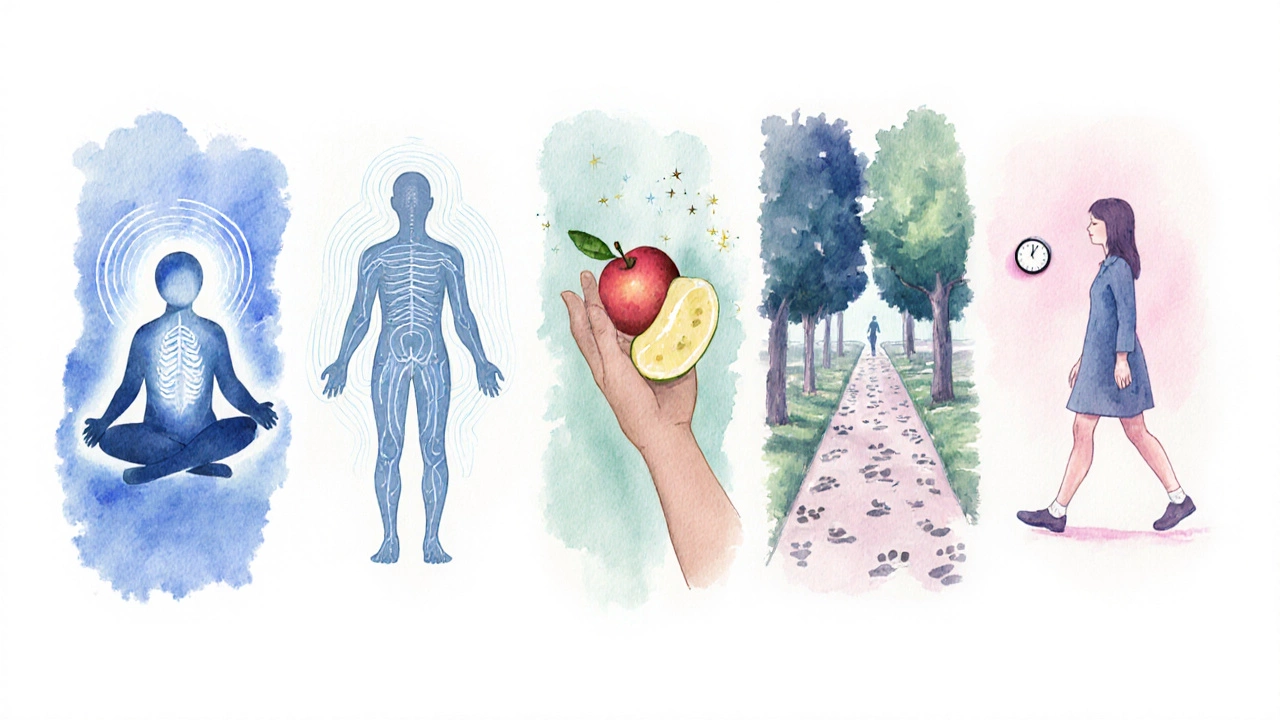Mindfulness Pause Calculator
Practice Your Mindfulness Pause
This exercise helps you create space between what happens and how you react. Follow the three questions from the article:
You created space between stimulus and reaction
By answering the three questions, you've trained your attention muscle. This pause is where choice lives.
Your current state:
"
"
How This Works
Based on the article:
When you hear the word mindfulness, you might picture a monk sitting in silence or a yoga class with soft music. In reality, mindfulness is a plain‑language tool you can use any time, anywhere, to quiet the mental chatter and stay grounded in what’s happening right now.
Mindfulness is a mental habit that keeps your attention focused on the present moment without judging what you experience. It’s less about adopting a new belief system and more about training a muscle - the attention muscle - so it can stay steady even when life feels chaotic.
What Mindfulness Really Means
At its core, mindfulness asks three simple questions each time you bring awareness to an experience:
- What am I noticing right now?
- How does it feel in my body?
- What am I thinking about it?
If you answer honestly, you create a tiny pause between stimulus and reaction. That pause is where choice lives - you can choose to react calmly, or let old habits take over.
Core Principles of Mindfulness
Even though the practice feels informal, it rests on four well‑studied pillars:
- Present‑moment awareness: Directing attention to the here and now, whether you’re sipping tea or stuck in traffic.
- Non‑judgment: Observing thoughts and feelings without labeling them "good" or "bad".
- Intentional focus: Choosing what to attend to instead of letting the mind wander aimlessly.
- Openness: Accepting whatever arises, even uncomfortable sensations, as part of the moment.
Simple Practices You Can Try Today
Below are five bite‑size activities that illustrate each pillar. No special equipment, no long sessions - just a few mindful breaths.
- Breathing exercise - Sit upright, inhale for a count of four, hold for two, exhale for six. Notice the rise and fall of your chest.
- Body scan - Starting at your toes, slowly move attention upward, naming any tension or ease you detect.
- Mindful eating - Choose a small bite of food, observe its texture, smell, and flavor before chewing.
- Walking meditation - With each step, feel the foot’s contact with the ground and the rhythm of your stride.
- Three‑minute pause - When you notice stress rising, stop, label the feeling, and take three slow breaths.

Backed Benefits: What Science Says
Research from universities worldwide shows that a regular mindfulness habit can do more than just calm the mind.
- Stress reduction: A meta‑analysis of 47 studies found an average 30% drop in cortisol levels after eight weeks of mindfulness training.
- Improved attention: Participants in a 2019 neuro‑study demonstrated a 15% increase in sustained attention scores after just 20 minutes of daily practice.
- Neuroplasticity: MRI scans show thicker prefrontal cortex regions in long‑term practitioners, supporting better emotional regulation.
- Better sleep: A randomized trial reported that adults practicing mindfulness before bed fell asleep 20 minutes faster.
Most of these outcomes stem from the same pause mechanism - giving the brain a chance to reset.
Common Misconceptions Debunked
Many newcomers think mindfulness is a religious ritual, a cure‑all, or a technique that requires hours of sitting. Here’s the reality:
- It’s secular: While roots trace back to Buddhist meditation, modern mindfulness is stripped of doctrine.
- It’s not a magic fix: Mindfulness reduces the impact of stress, but it won’t erase life’s challenges.
- It fits into a busy schedule: Even a 2‑minute breath check counts.

Step‑by‑Step Guide to Start Your Practice
Follow these eight steps to embed mindfulness into everyday life:
- Set an intention - Decide why you want to try it (e.g., "I want to feel calmer before work").
- Choose a cue - Use an existing habit (like brushing teeth) as a reminder to pause.
- Take three breaths - Inhale through the nose, exhale through the mouth, noticing the air.
- Label the sensation - Silently say, "I notice tension in my shoulders".
- Return to the breath - If thoughts drift, gently guide focus back without criticism.
- Expand the window - After a week, add a 5‑minute formal session (e.g., body scan).
- Track progress - Jot down moments when the pause helped you respond better.
- Be patient - Benefits compound over weeks; consistency beats intensity.
Mindfulness vs. Meditation: Quick Comparison
| Aspect | Mindfulness | Meditation (Focused‑Attention) |
|---|---|---|
| Goal | Stay present in everyday activities | Achieve sustained concentration on a single object |
| Typical Duration | Seconds to minutes throughout the day | 10‑45 minutes per session |
| Setting | Anywhere - work desk, kitchen, bus stop | Quiet space, often seated |
| Primary Technique | Observe thoughts/feelings without attachment | Focus on breath, mantra, or candle flame |
Frequently Asked Questions
Can I practice mindfulness if I have a busy job?
Absolutely. The smallest pause - three conscious breaths - can be done between meetings, while waiting for a coffee, or even during a short walk to the printer.
Do I need any special equipment?
No. All you need is a quiet moment and a willingness to notice what’s happening inside and around you.
How long does it take to feel the benefits?
Most people report a subtle sense of calm after a week of daily 2‑minute practice. Deeper changes, like improved focus, often appear after 4‑6 weeks.
Is mindfulness the same as day‑dreaming?
No. Day‑dreaming drifts without awareness. Mindfulness keeps you anchored, even if the mind wanders, by gently guiding attention back.
Can children practice mindfulness?
Yes. Simple games like "notice five sounds" turn the practice into a fun activity for kids.
Mindfulness doesn’t require a life overhaul - just a curious mind willing to pause, notice, and let go. Start with a single breath today, and watch how that tiny habit reshapes the way you experience the world.





